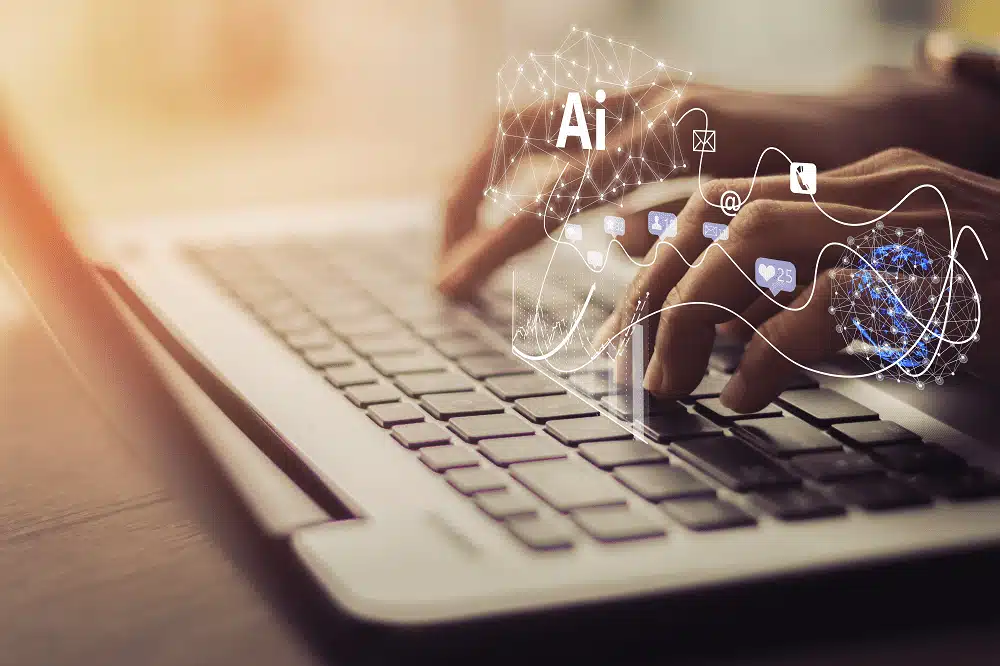Applications Of Generative AI In The Business World

In the fascinating world of generative Artificial Intelligence (AI), technology can generate entirely new and unique content. From writing code and composing emails to designing 3D products and creating images and videos – with generative AI, our creative potential isn’t limited by our technical abilities anymore. The technology helps bring our imaginative ideas to life.
By giving a simple prompt or instruction, generative AI models can generate content that truly reflects our imagination. This is the power of generative AI.
In recent months, generative AI has accomplished remarkable feats that were once impossible. It revolutionized how we create and consume content in business and creative industries. According to a report by Acumen research – the generative AI market size will achieve USD 110.8 billion by 2030, growing at 34.3%.
Let’s see the various applications of generative AI and explore real-world examples of how businesses and organizations utilize this technology in their operations.

Generative Ai Business Applications | Different Ways It Be Used
Generative AI has endless potential applications, both for business and personal use. It helps businesses make realistic simulations, create new product designs and streamline operations. For personal use, it can create digital art, compose music, and provide valuable information and advice on every possible topic.
Writing
Generative AI has already heavily impacted the writing industry. For all sorts of writing and language processing, AI is highly effective. Content creation, translation, copywriting, and all sorts of language processing work can complete tasks that would’ve previously taken a lot of human effort and time, in seconds.
Platforms like Jasper, Ryter, and dozens of others have proven to be particularly adept in these fields. ChatGPT from OpenAI has taken things to the next level by integrating programming language processing. It can even easily write and debug codes for you.
Image and Video Synthesis
Generating AI videos and working with images are among the most interesting aspects here. Generative AI companies like D-ID let users create real-life videos and animate faces just by uploading a photograph, while others provide a bank of pre-made avatars that you can operate like a digital puppet. There are also early versions of text-to-video that let you “direct” a scene, using a series of prompts This has diverse use cases and is developing fast, with mind-blowing potential.

Art and Design
For painting, illustration, photography, graphic design, and other forms of art, generative AI has given people creative wings that start flowing like a river just with simple text instruction. Platforms like DALL-E 2, Midjourney, and Stable diffusion have allowed millions of people to access AI-generated art, in some cases for free, and has taken the internet world by storm. These tools can be used to create 3D presentations, interior design, and product design thanks to different generative AI like DreamFusion by Google.
Music
Similarly, using simple prompts, you can create new music, make compositions, and produce tunes. This gives everyone the power to make things less complicated and create awesome music in a few simple steps. AI tools like ORB composer, Jukebox, and Boomy are among the few popular ones.
Successful integrations of generative AI business operations
Many businesses have already successfully implemented generative AI in various industries to improve efficiency, reduce costs, and drive innovation. Almost every sector, from marketing and healthcare to retail and finance, has leveraged this technology to enhance operations.
Big tech companies like NVIDIA use generative AI to create realistic images and videos of objects, animals, and even entire scenes in many cases. This can be easily used for virtual demonstrations, special effects, or video game graphics. Another example from NVIDIA is its partnership with biotech startup Ecozyne to create new proteins. These efforts can have a positive impact on helping human health as well as climate change.
Absci Corporation, another big name in the medical field, has announced its use of generative AI to create new antibodies.
Even fashion companies like Zalando and Stitch Fix have used AI to enhance and revolutionize their operations. The fashion industry can use generative AI to design new clothing items, generate virtual fashion shows, and much more.
Millions of people are using generative AI tools like ChatGPT and Midjourney every day to change their work lives. For example – Danny Waites, a data analyst at Embryo Digital, told UKTN that ChatGPT has significantly helped him in his work life. It gets tough for someone to remember the functions of the Python library (coding language), but now, he doesn’t have to.
There are countless more examples of people getting super creative on social media, using different generative AI tools.

The ethical dilemma regarding generative AI
As generative AI becomes more prevalent, valid concerns have come up about its impact and the ethical implications of its use.
One argument is that using AI in creating art and other forms of content is seen as “cheating” and disrespectful to those who have honed their skills through hard work. Plus, there are concerns that using generative AI could lead to job displacement.
Another significant ethical concern is the potential for misuse, such as: the creation of deep fake videos or the generation of highly realistic images for impersonation without consent, which can have severe consequences for an individual’s privacy.
Governments, businesses and organizations must consider these ethical considerations when developing and implementing generative AI models. This helps ensure the technology is used responsibly and that the rights and interests of all individuals are protected.
End note
Generative AI is already significantly impacting our world. As technology advances, it has the potential to revolutionize many aspects of our lives. We’re fortunate to live in a time when disruptive technology is rapidly shaping our future.
AI isn’t here to replace us. It’s here to augment our capabilities and improve our efficiency. Just like a calculator, which can help solve mathematical problems but won’t replace the expertise and guidance a dedicated math teacher provides.
I encourage everyone to take the opportunity to explore the latest advancements in generative AI technology. The possibilities are limitless and it’s exciting to see how they can be applied in various aspects of our life.
Frequently Asked Questions
In what ways can generative AI be used?
Generative AI can be used for creating new and unique data, simulations, personalized content, synthetic data for training models, product design, natural language responses, testing, data augmentation, art creation, and for many other things.
Are there any specific industries or businesses that would benefit from using generative AI?
Generative AI can be applied to different industries to improve efficiency, reduce costs, and drive innovation. Some industries include – media and entertainment, healthcare and medicine, manufacturing, gaming, finance, education, and others.
Can generative AI be used to create unique and personalized content?
Yes, it’s possible to create unique and personalized content with generative AI. You can create unique videos, images, art, music, and other types of content.
How does generative AI increase efficiency and productivity?
Instead of mastering a certain tool, which might take years, one can make something or do something with a few clicks and general written instructions.
Are there any ethical considerations surrounding the use of generative AI?
Some people are concerned about different misuse of generative AI and ambiguities over the ownership of AI-generated content.
Was this post useful?
Thank you for your feedback!


